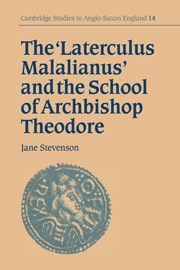Book contents
- Frontmatter
- Contents
- Preface
- List of abbreviations
- 1 Introduction
- 2 The contents of the Laterculus
- 3 Date and origin of the Laterculus
- 4 The nature of the Laterculus
- 5 Sources of the Laterculus
- 6 The Latinity of the Laterculus
- 7 Translational technique of the Laterculus
- 8 Manuscripts
- 9 Conclusion
- Text and Translation
- Commentary
- Appendix: Variant and anomalous biblical texts
- Bibliography
- Index of biblical sources
- General Index
3 - Date and origin of the Laterculus
Published online by Cambridge University Press: 20 March 2010
- Frontmatter
- Contents
- Preface
- List of abbreviations
- 1 Introduction
- 2 The contents of the Laterculus
- 3 Date and origin of the Laterculus
- 4 The nature of the Laterculus
- 5 Sources of the Laterculus
- 6 The Latinity of the Laterculus
- 7 Translational technique of the Laterculus
- 8 Manuscripts
- 9 Conclusion
- Text and Translation
- Commentary
- Appendix: Variant and anomalous biblical texts
- Bibliography
- Index of biblical sources
- General Index
Summary
My reasons for deducing that the Laterculus was written by Archbishop Theodore are essentially circumstantial. To begin with, this is a seventh-century text, written in Latin by a man whose education in the Greek patristic tradition is both wide and deep, and whose knowledge of Latin (both the language and its literature) is relatively superficial. This in itself is a highly anomalous state of affairs. There were numbers of Greeks active in the west in the seventh century, but they seldom wrote in Latin. Furthermore, the very few Latin works which the author of the Laterculus can be shown to have known are paralleled in the known contents of the library at Canterbury. There are only two Latin poets who can be shown to have impressed him, both Christian writers: Caelius Sedulius and Faltonia Betitia Proba. Proba's Cento was very little read in the early Middle Ages, but it was known to Aldhelm, who was partly trained in the school at Canterbury. Furthermore, Caelius Sedulius was one of Aldhelm's favourite authors. There are also two passages which suggest that the author of the Laterculus had read Gildas. Gildas was very well known to Aldhelm, but on the other hand there is little or no indication that he was read at all outside the Celtic west and England in the early Middle Ages.
Another fact which can be deduced about the author of the Laterculus is that he was probably familiar with the city of Rome, because he refers to a great church dedicated to the Virgin, which had just been built on the Capitol.
- Type
- Chapter
- Information
- Publisher: Cambridge University PressPrint publication year: 1995

